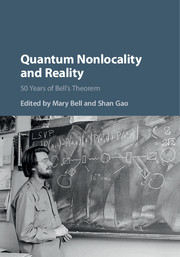Book contents
- Frontmatter
- Contents
- Contributors
- Preface
- Preface
- Part I John Stewart Bell: The Physicist
- Part II Bell's Theorem
- Part III Nonlocality: Illusion or Reality?
- Part IV Nonlocal Realistic Theories
- 19 Local Beables and the Foundations of Physics
- 20 John Bell's Varying Interpretations of Quantum Mechanics: Memories and Comments
- 21 Some Personal Reflections on Quantum Nonlocality and the Contributions of John Bell
- 22 Bell on Bohm
- 23 Interactions and Inequality
- 24 Gravitation and the Noise Needed in Objective Reduction Models
- 25 Towards an Objective Physics of Bell Nonlocality: Palatial Twistor Theory
- 26 Measurement and Macroscopicity: Overcoming Conceptual Imprecision in Quantum Measurement Theory
- Index
- References
22 - Bell on Bohm
from Part IV - Nonlocal Realistic Theories
Published online by Cambridge University Press: 05 September 2016
- Frontmatter
- Contents
- Contributors
- Preface
- Preface
- Part I John Stewart Bell: The Physicist
- Part II Bell's Theorem
- Part III Nonlocality: Illusion or Reality?
- Part IV Nonlocal Realistic Theories
- 19 Local Beables and the Foundations of Physics
- 20 John Bell's Varying Interpretations of Quantum Mechanics: Memories and Comments
- 21 Some Personal Reflections on Quantum Nonlocality and the Contributions of John Bell
- 22 Bell on Bohm
- 23 Interactions and Inequality
- 24 Gravitation and the Noise Needed in Objective Reduction Models
- 25 Towards an Objective Physics of Bell Nonlocality: Palatial Twistor Theory
- 26 Measurement and Macroscopicity: Overcoming Conceptual Imprecision in Quantum Measurement Theory
- Index
- References
Summary
Prologue
A memorial conference for John Bell, open to the public, was held at Rutgers University around 20 years ago. I gave a short talk there on Bell's views about David Bohm's “hidden variables” formulation of quantum mechanics, a version of quantum mechanics often called the de Broglie–Bohm theory or Bohmian mechanics. This theory was in fact discovered by Louis de Broglie in 1927. In 1952, it was rediscovered and developed by Bohm, who was the first to appreciate its connection to the predictions of standard quantum mechanics. I did not publish the talk.
I have decided that it would be appropriate to publish a very lightly edited version of it here, in this volume devoted to the work of Bell on the foundation of quantum mechanics. One reason for doing so is that the connection between Bell and Bohm continues to be somewhat underplayed, with the strength of his advocacy of Bohmian mechanics not properly appreciated. For example, about half of the papers in Bell's collected works on the foundations of quantum mechanics deal with Bohmian mechanics. But in his fine introduction to the revised edition of this great book [1], Alain Aspect mentions this theory in only a single sentence, and parenthetically at that.
For several decades after Bell proved his nonlocality theorem, based in part on Bell's inequality, it was widely claimed that Bell had shown that hidden variables – and Bohmian mechanics in particular – were impossible, that they were incompatible with the predictions of quantum mechanics. For example, the great physicist Eugene Wigner, who, unlike most of his contemporaries, was profoundly concerned with the conceptual foundations of quantum mechanics and usually wrote on the subject with great clarity and insight, has written that
This [hidden variables] is an interesting idea and even though few of us were ready to accept it, it must be admitted that the truly telling argument against it was produced as late as 1965, by J. S. Bell … This appears to give a convincing argument against the hidden variables theory.
- Type
- Chapter
- Information
- Quantum Nonlocality and Reality50 Years of Bell's Theorem, pp. 363 - 371Publisher: Cambridge University PressPrint publication year: 2016



